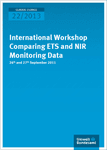International Workshop Comparing ETS and NIR - Monitoring Data
Abstract
To prepare for upcoming reporting challenges under Monitoring Mechanism Regulation (MMR, EU/525/2013) and Monitoring and Reporting Regulation (MRR, EC/601/2012) joint by the Effort Sharing Decision (ESD, EC/409/2009), The Federal Environment Agency (Umweltbundesamt [UBA]), The German Emissions Trading Authority (DEHSt), The Institute for Futures Studies and Technology Assessment (IZT Berlin) and the engineering company Mueller BBM launched the DENK research project in 2011. The main subject of this project was the comparison between plant-specific data of the European Emission Trading System (EU ETS) and the data and methods used for preparation of source category-specific annual inventories, according to the EU monitoring mechanism and the national reporting under the United Nations Framework Convention on Climate Change (UNFCCC) Project results were presented during a two-day workshop on 26 and 27 September 2011 in Berlin. The working field addressed was a comparison of the EU ETS and UNFCCC data and the reporting processes in the specific sectors. Subsequently, the results were discussed and, likewise, launched activities on this topic in other EU countries were presented. Ongoing activities of the EU concerning revision of the EU ETS, especially in relation to the EU Decision No 280/2004/EC and EU Directive 2003/87/EC, were not a core focus of this workshop. General information concerning emerging challenges and upcoming requirements associated with this revision were given as an outlook at the end of the workshop. International experts from nine European countries (Belgium, Denmark, Finland, France, Germany, Greece, Norway, Sweden and the United Kingdom) presented their countries' experiences at the workshop by using ETS data for inventory compilation. The main thematic focuses were refineries, the iron and steel sector, the energy sector and the mineral industry (i.e. cement and ceramics). In conclusion, an outlook was formulated regarding additional gases and activities which fall under the ETS from 2013 on. The final conclusion emphasized that ETS data could enhance specific NIR data and vice versa - knowledge of both monitoring guidelines is pre-conditioned, appropriate by Article 5 of MMR (EC/525/2013) adopted in May 2013
